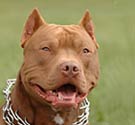 |  |  |  |
|---|---|---|---|
 |  |  |  |
| American pit bull terrier, American Staffordshire terrier, Staffordshire bull terrier and American bulldog. | |||
Q: What is a pit bull?
The legal definition of a pit bull is a class of dogs that includes the following breeds: American pit bull terrier, American Staffordshire terrier, Staffordshire bull terrier, American bulldog1 and any other pure bred or mixed breed dog that is a combination of these dogs. Weight and shape can vary significantly amongst pit bulls, from 35 to 100 plus pounds. (Please see Disguise Breed Name to learn more about the deliberate renaming and mislabeling of pit bulls throughout history.)
Q: What is the history of the pit bull?
The blood sport of "bull baiting" began over 1,000 years ago in England (various sources dispute this date). What is undisputed is that by 1500, bull baiting had progressed to Britain's national pastime. Bulldogs were reportedly first mentioned by name in 1631, referring to their function rather than a distinct dog breed. By 1800, and through further selective breeding, the bulldog developed into a compact muscular dog characterized by tremendous jaw strength.2
Due to public outrage, bull baiting was banned in England in 1835. Bulldog breeders and owners then moved to the sport of "ratting," where a number of rats were placed into a pit and wagers were made on how many rats the dog could kill in a certain time period. To increase agility, quickness and prey-drive in the bulldog, ratters crossed the breed with terriers. Essentially, it was the sport of ratting that combined the bulldog and terrier into the modern day pit bull terrier.
On the heels of ratting, dogfighting developed. Pit bulls and dogfighting were exported to America as settlers made their way to the New World. In 1884, the American Kennel Club was formed but rejected pit bulls due to their use in dogfighting. In response, Chauncey Z. Bennett formed the United Kennel Club in 1898 to bring formal recognition to the pit bull breed. At that time, Bennett also drew up rules and regulations for dogfighting to bring "organization" to the blood sport.3
Q: What is dogfighting and what does it have to do with pit bulls?
Pit bulls are the dog of choice amongst dogmen, individuals who fight their pit bulls against other pit bulls. Dogmen consider pit bull terriers, who they commonly call "100% bulldogs," to be the ultimate canine gladiator. Pit bulls were selectively bred for "gameness," the ability to finish a fight. A truly gamedog will continue fighting "on stumps," two or more broken legs, and far worse.4 (Please see excerpts from The Complete Gamedog, by Ed and Chris Faron to learn more).
The blood sport of dogfighting involves a contest between two dogs, primarily pit bulls, fighting each other in front of spectators for entertainment and gambling purposes. Other felonious activities, such as illegal drugs, often accompany dogfight matches. A single dogfight averages about an hour in length but can last two or more.5 A dogfight begins when a referee says, "Face your dogs," then says, "Let go." The fight ends when one of the dogs will not or cannot continue.
The arrest and conviction of Michael Vick shows that dogfighting still proliferates in the U.S. Law enforcement education, however, is on the rise. In 2008, Edward Faron of Wildside Kennels, known as the "godfather" of dogfighting, was arrested and charged. Faron pleaded guilty to 14 counts of felony dogfighting.6 In 2009, authorities unleashed an 8-state simultaneousdogfighting sting and seized over 450 dogs.7 In 2013, a string of at least six major raids occurred as well.8
Q: Why do I always read about pit bulls in the news?
When a pit bull attacks, the injury inflicted may be catastrophic. First responders, such as police officers and firefighters, understand this as do members of the media, who are quick to report these attacks. Ongoing social tension also keeps pit bulls in the news. The pit bull problem is now over 30-years old.9 In this time, most lawmakers have been "too afraid" to take breed-specific action to correct the problem. Due to this failure, horrific maulings continue to make headlines.
About half of all media reports regarding pit bulls involve police officers shooting dangerous pit bulls in the line of duty.10 Since the late 1970's pit bulls have been used extensively in criminal operations for drug dealers, gang members and other violent offenders. The pit bull terrier is the breed of choice for criminals. This choice is directly linked to the pit bull's selectively bred traits of robust jaw strength, a deadly bite style, tenacity (gameness) and a high tolerance to pain.11
Q: Why do people say that pit bulls "don't let go?"
Through selective breeding, pit bulls have developed enormous jaw strength, as well as a ruinous "hold and shake" bite style, designed to inflict the maximum damage possible on their victims. This bite trait delivered winning results in the fighting pit. When the Colorado Supreme Court upheld the Denver pit bull ban in 2005, the high court set aside characteristics that pit bulls displayed when they attack that differ from all other dog breeds. One of these characteristics was their lethal bite:
"[pit bulls] inflict more serious wounds than other breeds. They tend to attack the deep muscles, to hold on, to shake, and to cause ripping of tissues. Pit bull attacks were compared to shark attacks."12
Leading pit bull education websites, such as Pit Bull Rescue Central, encourage pit bull owners to be responsible and to always carry a "break stick" -- a tool used to pry open a pit bull's jaws -- in case their dog "accidentally" gets into a fight. These same websites also warn that using a break stick on any other dog breed may cause serious injury to the person.13 This is true because no other dog breed possesses the pit bull's tenacity combined with a "hold and shake" bite style.
One of the most powerful examples of a pit bull "not letting go" occurred in an Ohio courtroom. During the Toledo v. Tellings trial (Tellings was convicted of violating the City of Toledo's pit bull ordinance), Lucas County Dog Warden Tom Skeldon showed a videotape of a tranquilized pit bull hanging from a steel cable. The dog is essentially unconscious and still does not release its grip. At the time of the taping, the pit bull was being housed at the Lucas County Animal Shelter.14
Q: Do pit bulls bite more than other dogs?
Depending upon the community in which you live and the ratio of pit bulls within it, yes and no. But whether a pit bull bites more or less than another dog breed is not the point. The issue is the acute damage a pit bull inflicts when it does choose to bite. The pit bull's "hold and shake" bite style causes severe bone and muscle damage, often inflicting permanent and disfiguring injuries. Moreover, once a pit bull starts an attack, firearm intervention may be the only way to stop it.
When analyzing dog bite statistics, it is important to understand what constitutes a bite. A single bite -- recorded and used in dog bite statistics -- is a bite that "breaks the skin." One bite by a poodle that leaves two puncture wounds is recorded the same way as a pit bull mauling, which can constitute hundreds of puncture wounds and extensive soft tissue loss. Despite the "quagmire" of dog bite statistics, pit bulls are leading bite counts across U.S. cities and counties.15
No comments:
Post a Comment